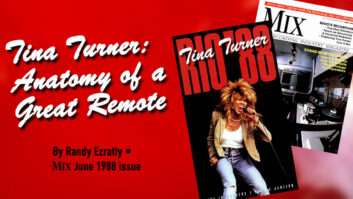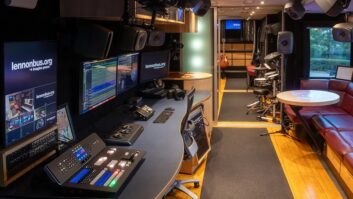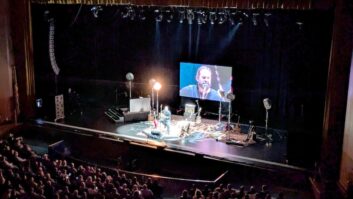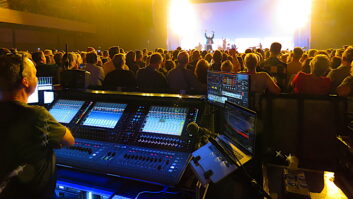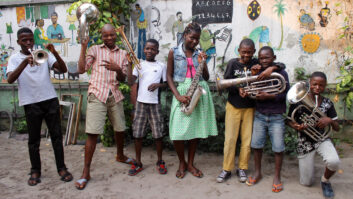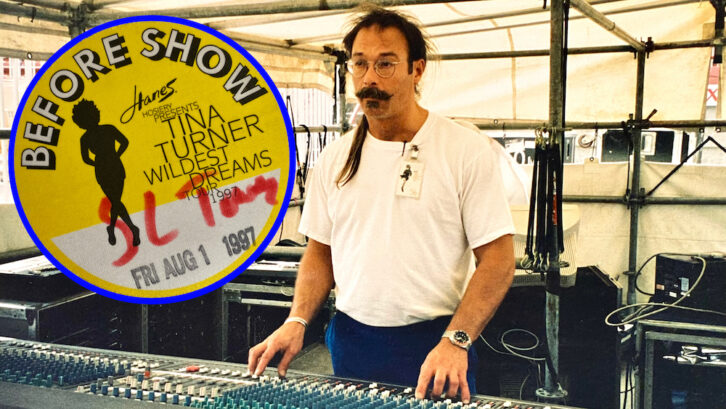
This article appeared in the October 1997 issue of Pro Sound News, covering the end of the 18-month-long Tina Turner “Wildest Dreams” tour.
New York (October, 1997)—By August, everyone on the Tina Turner tour was looking forward to some time off. Having started 18 months earlier in March, 1996, the production arrived in New York some 300-plus shows later with a mere eight performances left; going home was a popular topic of conversation.
“Everyone’s ready to stop—even Tina’s ready: She toured last year for 10 months and had one week off in that time,” remarked Chad Shreiner, system engineer for the Clair Bros. rig with which Turner was traveling. He, system tech Kirk Shreiner and FOH engineer Dave Natale were the only members of the six-man sound crew to do the entire tour. Natale, who’s been Turner’s FOH engineer since 1985, repeatedly characterized Turner as “a traditionalist” and the same could be said for his own approach to mixing; for instance, there was little in the way of effects at the FOH position. “See, I actually mix,” he said, wryly. “I push the faders up and down, like, a lot during the show. I do it myself, it makes it more interesting. Plus I think I’m a better limiter than any box anyway.”
| VITAL STATS: TINA TURNER 1997 ‘WILDEST DREAMS’ TOUR |
| FOH Engineer: Dave Natale Monitor Engineer: Ed Dracoules Monitor Assistant: Doug “Sluggo” Deems System Engineer: Chad Shreiner System Tech: Kirk “Eek” Shreiner System Tech: Viggy |
| FOH Console: Yamaha PM4000, PM3000 Monitor Console: Yamaha PM4000M, Ramsa WR-S840 House Speakers: (72) S-4 Series II Monitor Speakers: Clair 12AM, CBA Custom House Amplifiers: Carver / Clair Monitor Amplifiers: Carver / Clair, QSC FOH Equipment: TC Electronic M5000, 6032 EQ w/ 1128 remote; Yamaha SPX990; Aphex 612; dbx limiters Monitor Equipment: Yamaha REV5, SPX1000; Aphex gates; dbx limiters Microphones: beyerdynamic M88; Sennheiser 421, 431, 409, 406, 416; Shure 56, 57, 58, Beta58, 91, 98; AKG 451, 460, 414; CAD E-300; Countryman DI; Samson UR-5 |
Following similarly in that traditionalist vein, Natale noted that he had used the same makes of microphones for the last 15 years (“no point in changing unless there’s something worth changing to”). Not that he’s against change however—for instance, he added a “new” box to his set up a few years ago: “I run Tina’s voice through the Manley, which is an excellent limiter. You can’t hear it, just like a limiter should work. Tina’s vocal gets no Harmonizer, and reverb only if it’s exceptionally dry. She’s got a really good voice, so I don’t have to do anything to it.”
When the reverb is used, it’s also used in a straight-ahead fashion. “I’m not much for using different reverbs on different instruments,” said Natale, “because this is supposed to sound like it’s live. Everything has the same reverb on it, so it sounds like the band’s all playing in the same place at the same time.”
One of the things Natale had to contend with was a powerful stage sound created by a slew of sidefills and 40 monitor wedges—18 across the front of the stage just for Turner alone. Despite all those boxes, monitor engineer Ed Dracoules didn’t think the stage sound was that unusual, describing it as “Loud—same as most bands I work with.” Natale simply saw the stage level as something that just had to be dealt with, noting, “Tina needs to hear herself before she can sing anything into the PA—which is what I care about. I just EQ around it. Instead of going through a big song and dance about the wedges, it’s easier to just pull the vocal fader up and down a little bit every now and then.”
Tina Turner Rio ’88: Anatomy of a Great Remote
With all the boxes on stage and the fact that the show was all singing and dancing, it was almost surprising that personal monitor systems weren’t used, if only to get wedges out the audience’s view of Turner’s shuffling feet. Shreiner explained, “Only the percussion/sax player is using personal monitors and he has a Clair Brothers system. It doesn’t get quite as loud as the other ones, but it’s very clean. We tried to give them to Tina, but she’s from the old school. She wanted to see boxes pointed at her, plus she has a lot of costume changes where she has to get back on stage fast, so they’d get in the way.”
Regardless of the stage sound, the PA often got turned up pretty high, too. “Tina likes the show to be powerful, so it gets as loud as it can,” Natale explained. Pushing the sound to the wall would be right in line with the rest of the show, however, which was a strong mix of over-the-top spectacle and performance, even with only eight shows left. As Shreiner pointed out, “She gives 120 percent every night, whether it’s a good audience or not. She still treats it like it’s the first show of the tour.”
